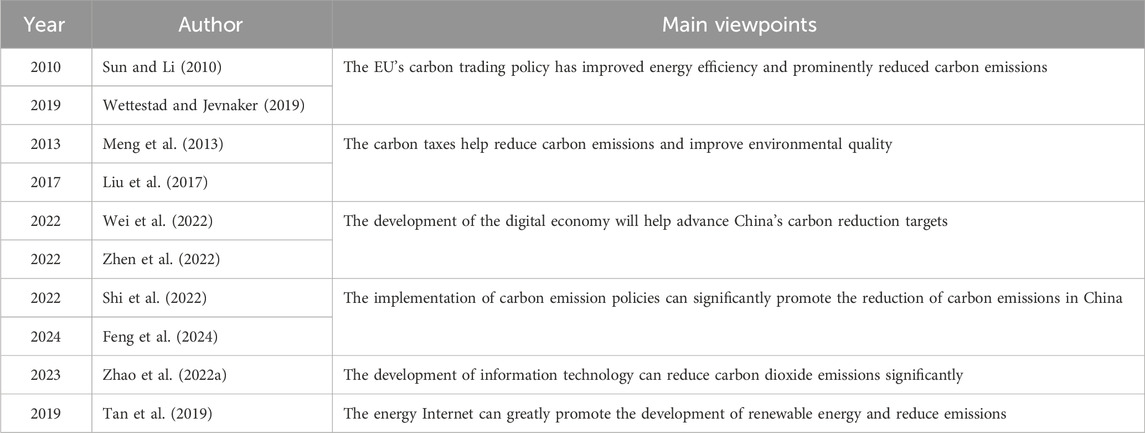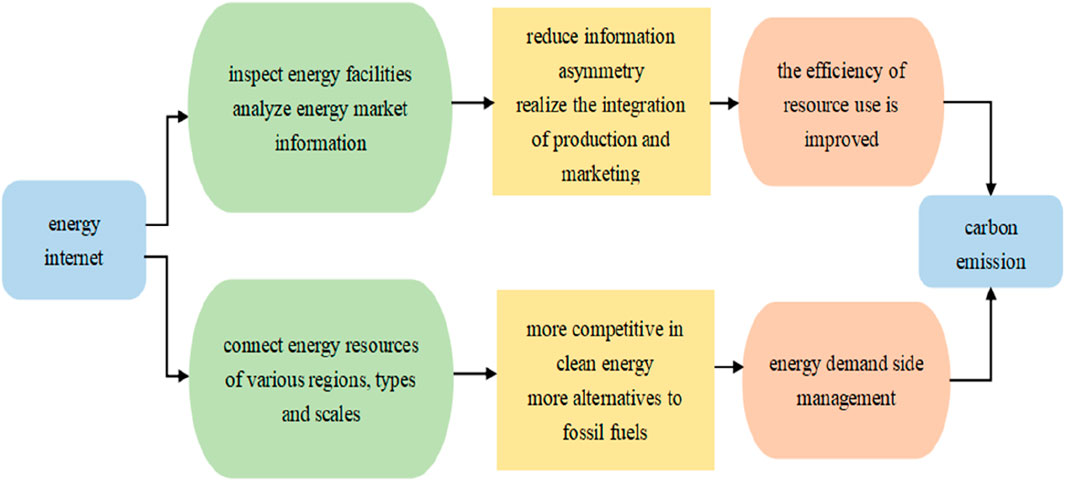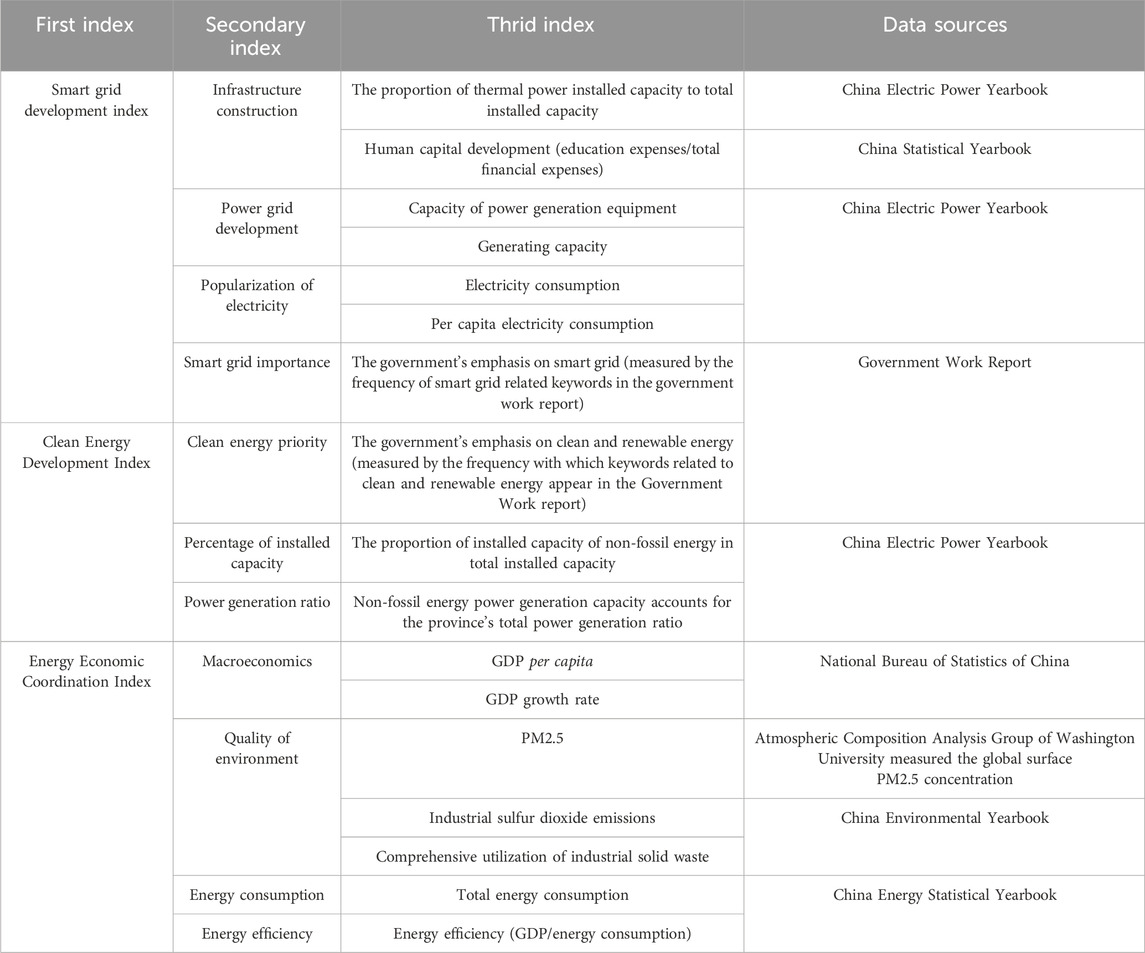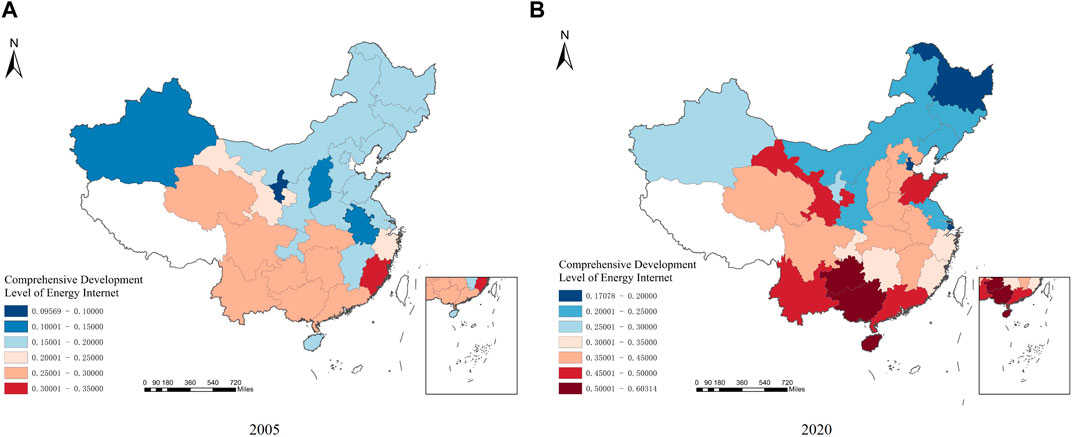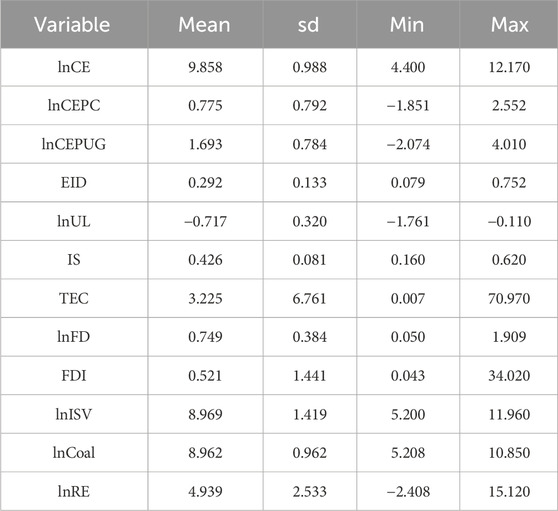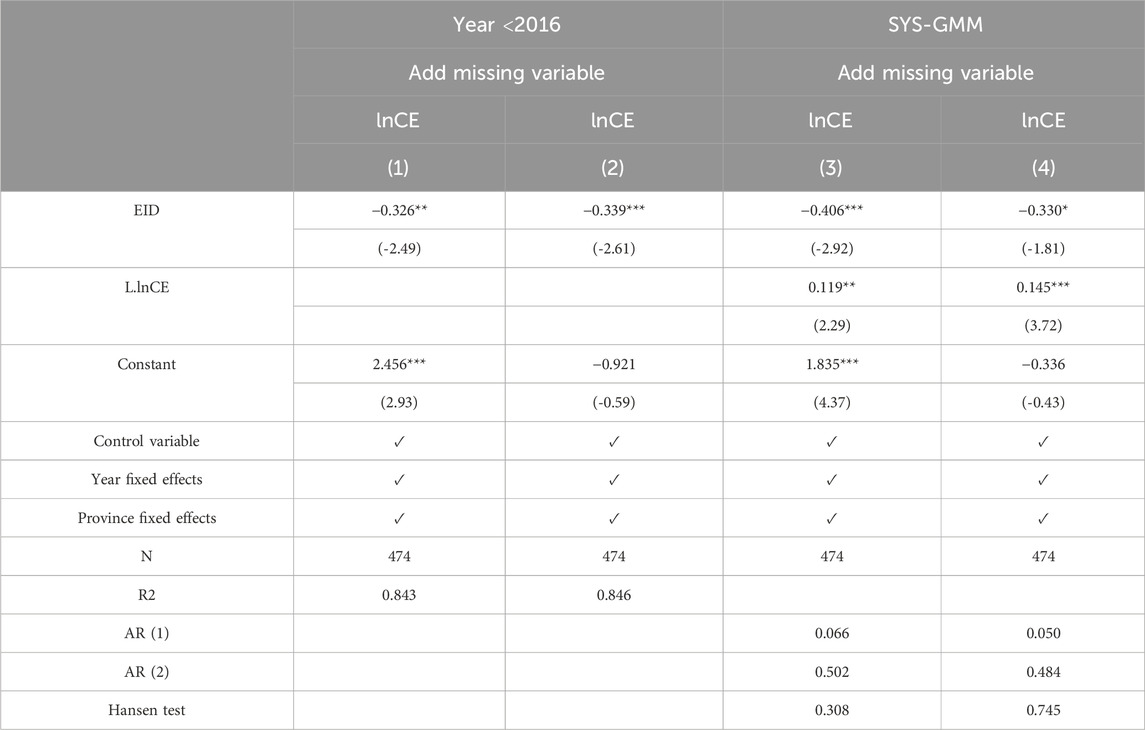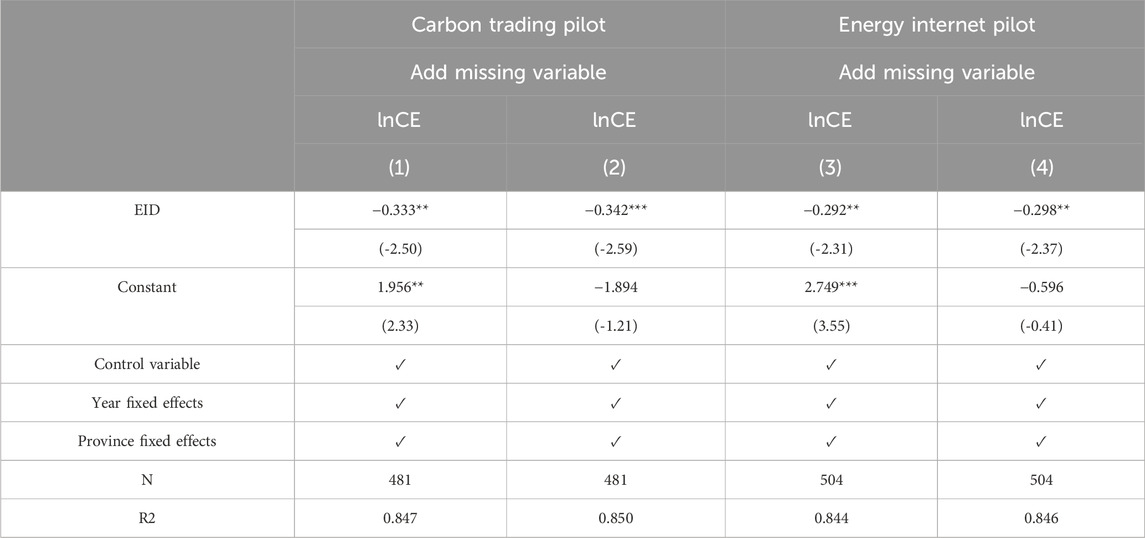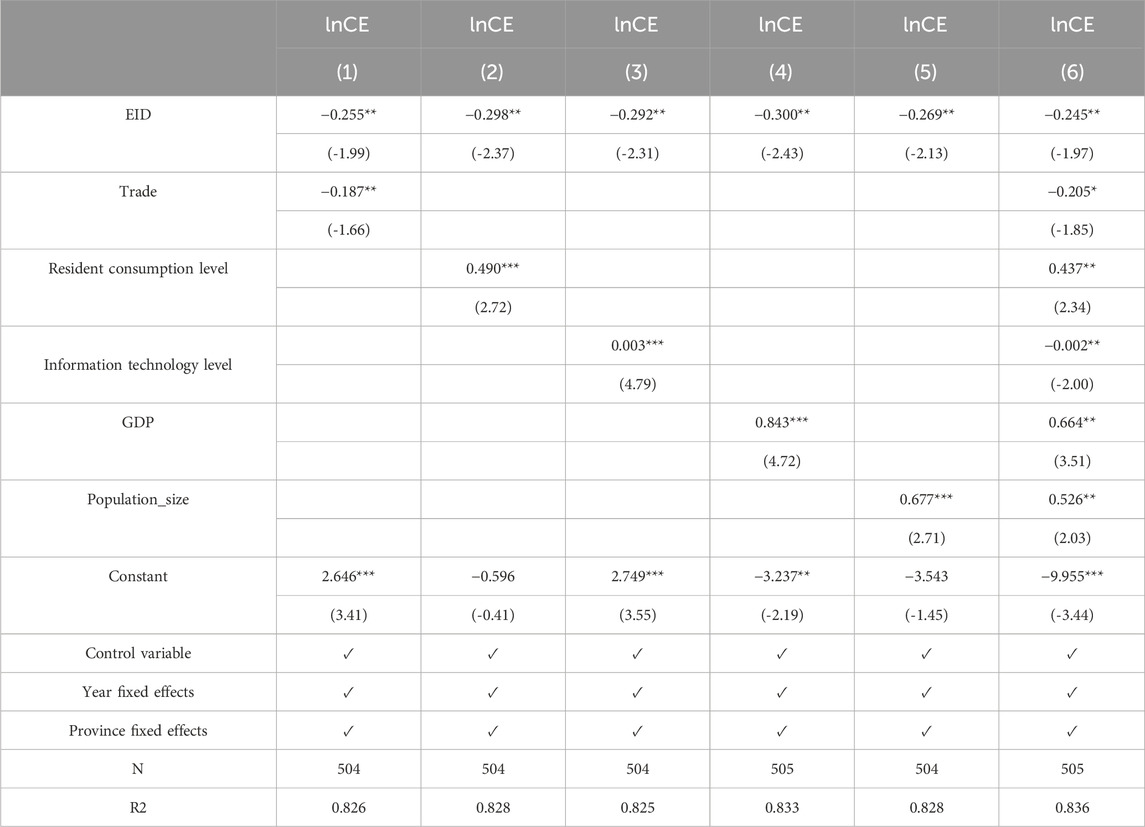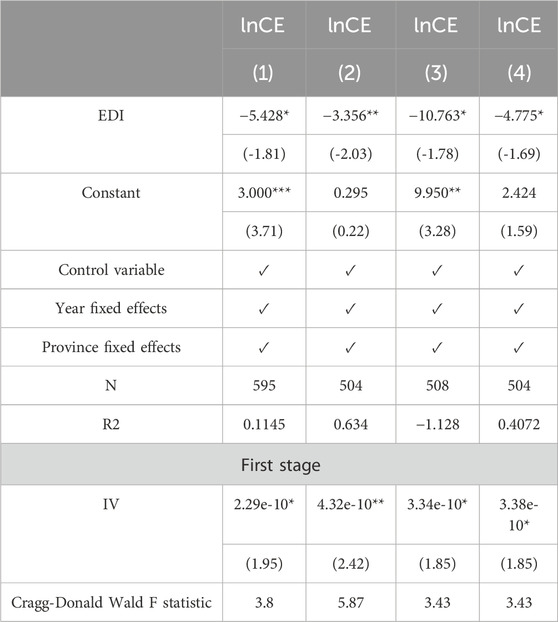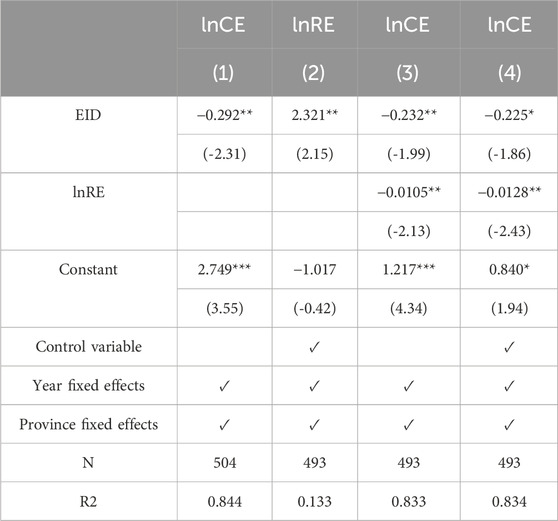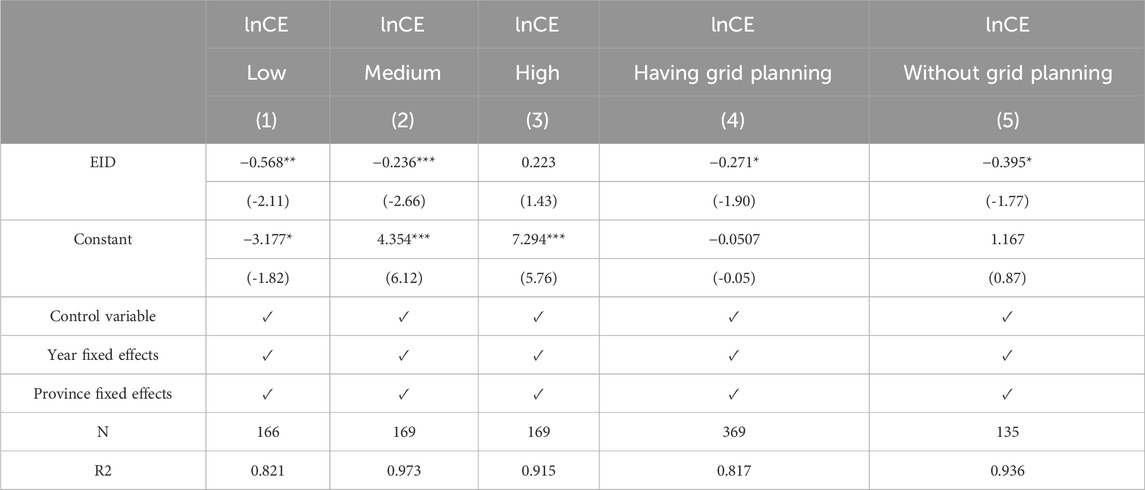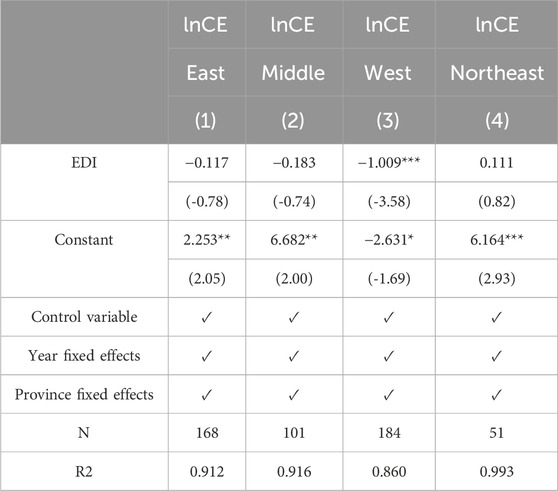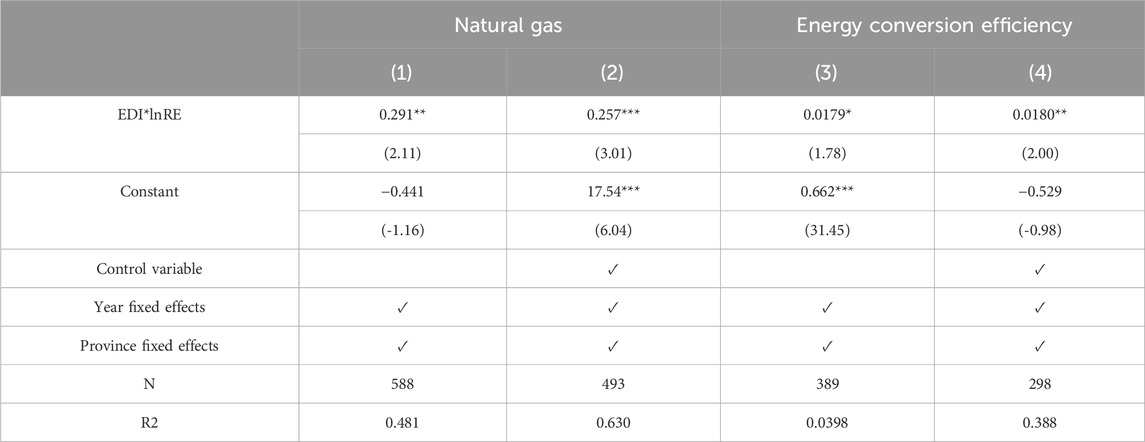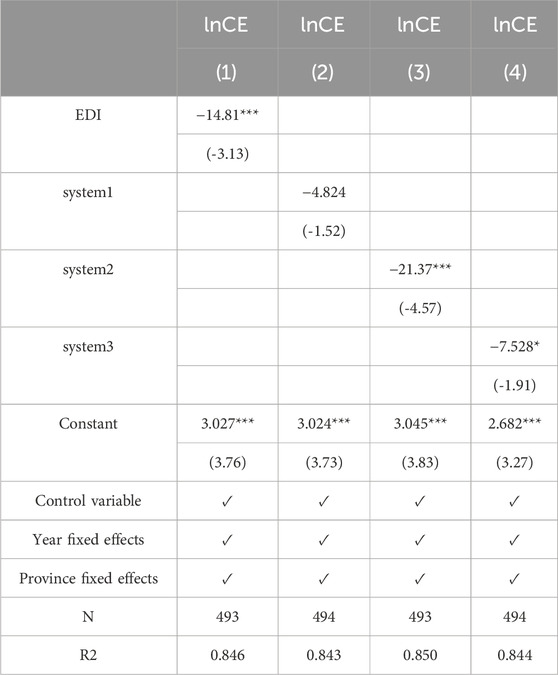Can the energy internet achieve carbon reduction?
- 1China Energy Jinjie Energy Co.,LTD, Yulin, China
- 2School of Economics and Management, Northwest University, Xi’an, China
- 3Carbon Neutrality College (Yulin), Northwest University, Xi’an, China
- 4Xi’an Carbon Neutral Ecological Technology Consulting Co, LTD, Xi’an, China
Based on panel data for 30 provinces in China from 2000 to 2020, this paper uses entropy method to construct the integrated development indicators of energy Internet, and explores the impact of the development of the energy Internet on reducing carbon emissions in China and its internal transmission mechanism. The research results show that the development of energy Internet can significantly reduce regional carbon dioxide emissions, and increasing the use of renewable energy is an important mechanism for the comprehensive development of energy Internet to curb carbon emissions. Heterogeneity analysis shows that the emission reduction effect brought by the development of energy Internet is more remarkable in the regions with lower carbon emissions and western China. Furthermore, this paper finds that in the setting of the development of energy Internet, the development of renewable energy can promote natural gas consumption and advance energy conversion efficiency. The government’s emphasis on regional technology development has an external strengthening effect on carbon emission reduction. The research in this paper expands and diversifies carbon reduction pathways and provides reference for more developing countries to utilize the development of energy internet to achieve carbon reduction.
1 Introduction
As one of the problem of great concern in the world, greenhouse gas emissions cause global warming is rapidly endangering the survival of human beings, and the greenhouse gas generated by human activities is the dominating reason of global warming. The World Meteorological Organization (WMO) has reported that the period from 2015 to 2021 will be the world’s seven hottest years since the existence of complete meteorological observation records, and in the atmospheric greenhouse gas concentration and heat emissions, the increase of carbon dioxide concentration is particularly significant. In the face of severe climate challenges, how to better achieve carbon emission reduction has become a key issue of global concern.
As the largest developing country, since the reform and opening up, China’s development in economic level has made remarkable achievements. Meanwhile, the ecological environment has been seriously damaged, and the problem of carbon emissions caused by excessive consumption of large amounts of fossil energy has become increasingly serious. According to “Global Carbon Atlas” published data, Chinese carbon emissions accounted for 29% of the world in 2019, of which 9.8 billion tons of carbon emissions from energy activities, accounting for 87% of the total society, is the largest energy consumption and carbon emissions of the world. As China has been in the stage of rapid industrialization and urbanization for a long time, the coal-based energy system and the high-carbon emission industrial structure have made the total carbon emission and intensity appear double high. How to achieve energy structure transformation and carbon reduction is the direction of continuous efforts of the Chinese government.
Of course, as a responsible major country, at the 75th session of the United Nations General Assembly in September 2020, the China promised to achieve carbon peak by 2030 and carbon neutrality by 2060. Therefore, it is urgent to find an approach of new, clean and sustainable energy utilization system. The Internet field has been at the forefront of innovation and development, combining energy and the Internet, and the energy Internet came into being. As early as 2016, the National Energy Administration, the National Development and Reform Commission and the Ministry of Industry and Information Technology (of China) jointly issued the Guiding Opinions on Promoting the development of “Internet +" smart energy, marking the official beginning of the development of Chinese energy Internet. Subsequently, in April 2021, the Energy Internet Plan of the State Grid Corporation pointed out that the international leading energy Internet with Chinese characteristics should be fully built in 2035, and then energy Internet has developed rapidly.
The target that to build the energy Internet is to increase the proportion of renewable energy and the efficiency of traditional fossil fuels, radically change the energy consumption structure condition, and then uncouple economic development from fossil energy demand, and play a part in energy conservation and emission reduction while improving the efficiency of comprehensive energy utilization. The construction energy Internet construction generates the carbon emission reduction of the whole society with the zero-carbon revolution of the energy system, and plays an overall and dominating role in the development strategy of achieving carbon peak and carbon neutrality. Therefore, scientifically assessing the impact of China’s energy Internet development on carbon emissions, improving the development layout of energy Internet, and supporting the process of carbon emission reduction are urgent priorities to be faced and solved. Specifically, what is the effect of Chinese energy Internet development on carbon emissions? What are the key transmission factors affecting this outcome? Are the results heterogeneous among different regions and factor endowments? As well as whether the government highlights on scientific and technological development in regions will have externalities on the impact of energy Internet on emission reduction, these are the key issues to be solved in this paper.
The remaining structure of this paper is as follows: the second part is literature review, and next part is theoretical analysis and research hypothesis, the fourth part is model setting and data sources, the specific empirical results and analysis are shown in the fifth part, while the mechanism analysis and further expansion analysis will be presented in the sixth part and the seventh part, finally, the finding conclusions and policy suggestions of this paper will be seen in the last part.
2 Literature review
With the increasingly severe climate issues, the related researches on how to achieve carbon emission reduction show phased changes, and the focus of the research content is also different. At the beginning of the study, scholars focus on the study of carbon trading market, analyzing the design of carbon market and its emission reduction effect. Scholars have found in their research on the design of market mechanisms and their carbon reduction effects that establishing a carbon emission trading market and implementing carbon taxes can significantly reduce China’s carbon emissions (Lou, 2014; Liu et al., 2019; Wang and Zhao, 2019; Zhang et al., 2019; Qi et al., 2020; Yu et al., 2020; Liu et al., 2021). The pilot program of carbon emission trading in China mainly focus on free allowances. As early implementation of market mechanism to control carbon emissions, the European Union, a respresentative example, has carried out a reform of the carbon emission trading system characterized by dynamic, so the efficiency of its market information operation becomes higher (Lee et al., 2020) (Lee et al., 2020). In the initial phase of the EU carbon trading system, free quota allocation was also the prime way, but significant changes occurred in the third phase of the EU carbon trading mechanism reform (Dai et al., 2021) (Dai et al., 2021). Auction has been the main method of carbon quota allocation since 2013, and auctions under the carbon trading mechanism would gradually replace free allocation (Xiong and Qi, 2012; Liu, 2012; Cong and Wei, 2012) (Cong and Wei, 2012; Liu, 2012; Xiong and Qi, 2012). Lin and Jia (2020)conducted a detailed research on the industries covered by Chinese carbon market. They found that the more industries covered, the lower the carbon price is, thus the incentive for covered firms to reduce emissions was decreased. By covering only the cement, chemical, and power industries, carbon reduction targets can be achieved at lower regulatory costs (Lin and Jia, 2020). Qu et al. (2017) analyzed the scale of the carbon trading market and found that the larger the market size, the lower the cost of global emission reduction (Qu et al., 2017). Martin et al. (2016) also conducted a series of studies on the affect of the EU carbon trading mechanism on enterprises’ carbon emissions of (Martin et al., 2016). Besides, some scholars have discovered that an imposed carbon tax can benifit carbon emissions and environmental quality (Li and Peng, 2020) (Li and Peng, 2020).
As the digital economy grows, scholars have gradually started to keep a watchful eye on the emission reduction effect that digital economy brings. For foreign studies, Asongu et al. (2018) used GMM to measure the panel data of 44 African countries from 2000 to 2012 and discovered that ICT in the sample countries had a positive influence on carbon emissions, while its square term had a negative influence on carbon emissions (Asongu et al., 2018). In China, many scholars have also found through research that developing the digital economy will help China achieve its carbon reduction targets (Ming et al., 2022; Jun et al., 2022) (Jun et al., 2022; Yi et al., 2022). Ma et al. (2022) found that R&D investment has a positive moderating effect on the relationship between digital economy development and carbon reduction, and affirmed the carbon emission reduction effect of R&D investment and technological innovation (Ma et al., 2022). Xu et al. (2022) also agree with this view and believe that digital investment can help improve carbon emission efficiency (Xu et al., 2022). Zhou et al. (2022) analyzed the case of China and found that the expansion of digital demand and supply scale has led to an increase in digital carbon emissions. However, due to the improvement of industry carbon efficiency, digital production, and application structure, the growth of carbon emissions has shown a slowing trend (Zhou et al., 2022). Some scholars have studied the role of Taiwan’s digital development in circular economy and discovered that through digital waste management, raw material consumption can be reduced by 25% by 2030, while greenhouse gas emissions can be halved (Kurniawan et al., 2022) (Agustiono Kurniawan et al., 2022).
In addition, the development of energy Internet provides a new perspective for the study of carbon emission reduction. Laroussi et al. (2022) analyzed the potential benefits of the application of energy Internet in the power sector and proposed that the energy Internet will bring varying degrees of benefits to the three main links of power production, transportation and consumption, so as to reduce carbon dioxide emissions. Taking the future power grid interconnection in Africa as an example (Laroussi et al., 2022). The specific representative research views are shown in Table 1.
In summary, existing studies mainly concerns on the analysis of energy consumption generated carbon emissions (Moyer and Hughes, 2012), especially the emission reduction effect of renewable energy development (Muhammad et al., 2022) (Zhou et al., 2022). Zhao et al., 2022) (Moyer and Hughes, 2012; Zhao et al., 2022b; Shahbaz et al., 2022). Meanwhile, some research literature also pays attention to the influence of information technology development on carbon emissions (Yang et al., 2019; Zhao et al., 2022) (Yang et al., 2019; Zhao et al., 2023). Unfortunately, very little literature has focused on the influence of energy-information technology coupling on carbon emissions, which is a major flaw in existing research. The resulting research gap is as follows: how to construct an appropriate indicator system to more accurately measure the energy Internet development is not mentioned in the current literature and is ignored by scholars. At the same time, exploring whether the development of energy Internet can realize carbon emission reduction, and evaluating the effect relationship between the two sides is the urgent focus of current research. Further, it is high accurately identifying the development of energy Internet is caused by the internal transmission mechanism of carbon emission changes. For the above questions, the existing research literature does not give a clear answer.
In view of this, this paper tries to answer the above questions, and its potential marginal contributions are as follows: First, this paper gives a new perspective of energy Internet development to examine carbon emission reduction, providing a new research perspective for existing carbon emission reduction research; Secondly, on the basis of actual data of the development of China’s energy Internet, this paper attempts to construct an indicator system for the energy Internet development from multiple dimensions, and uses the entropy method to calculate, in order to obtain an accurate development level of energy Internet. Finally, the internal mechanism of the impact of the energy Internet development on carbon emissions is analyzed in depth at the theoretical level, and the impact of this mechanism is empirically tested by the intermediary effect model, which has a certain complementary role to the existing research.
3 Theoretical analysis and research hypothesis
Energy Internet is a complicated multi-network flow system with power system as its core, advanced Internet information technology as the basis, recognised renewable energy as the main primary energy, and closely connected with natural gas network, transportation network and other systems. One of the important characteristics of the energy Internet is the ubiquitous integration of energy production and marketing. It plays the role of both producer and consumer, and has the characteristics of intelligent regulation of energy and flexible regulation of energy market. The creation of the energy Internet, through the use of big data, artificial intelligence, Internet of Things and other technologies, aims to achieve real-time detection, diagnosis, prediction and control of all kinds of energy equipment and facilities, to achieve timely collection, analysis and response to all kinds of energy demand and market information, so as to reduce information asymmetry, optimize resource allocation. It can realize cooperative utilization of coal, electricity, gas, hydrogen and other energy across regions, and advance energy efficiency on utilization. Through using energy Internet can realize united two-way control between energy and carbon emissions, help to carbon emissions detection and trace, facilitate advance in carbon reduction technologies, and facilitate low-carbon green economics development. Hence, this paper comes up with the first research hypothesis.
H1:. The development of energy Internet can promote carbon reduction.
Chinese energy system mainly bases on coal and industrial structure is high-carbon, so both its total carbon emissions and carbon intensity appear “high” status, and Chinese coal consumption still accounts for over 50%. To settle the matter of carbon emissions, we need to realize the demand-side management of energy, change the mode of energy development, change the structure of energy consumption, and increase the proportion of clean energy and renewable energy. Energy Internet deeply integrates energy and information, comprehensively adopts advanced scientific information technology, power electronics and smart management, so that a large number of distributed energy collection and storage devices are connected with new power grids, natural gas networks, oil networks and other energy nodes, so as to achieve peer-to-peer energy exchange, two-way energy flow and network sharing. The energy Internet can realize the interconnection of energy resources of different regions, different types and different scales, form a multi-level, multi-dimensional and diversified energy supply system, solve the problems of intermittency and volatility of clean energy, and improve the consumption capacity and market competitiveness of clean energy. Wind, solar, water and other renewable energy plays the alternative role in replacing fossil fuels like coal, oil and other energy sources, and the use of these renewable energy sources produces carbon dioxide less than traditional energy does, which can reduce carbon emission. Based on this result, the second research hypothesis is raised.
H2:. The Energy Internet can restrain the carbon emissions increase by promoting people to use renewable energy sources. The specific pathways through which energy internet achieves carbon emission reductions are shown in Figure 1.
4 Methodology
4.1 Model design
4.1.1 Benchmark regression model
Based on the theoretical analysis and research hypotheses mentioned above, this paper constructs the following model of panel data:
Where, i denotes the province, t denotes the year,
4.1.2 Mediation effect model
Basic theoretical analysis and relevant literature reference (Li et al., 2022; Shi et al., 2023) (Li et al., 2022; Beibei et al., 2023), this paper constructs the following mediation effect model:
In Eqs 2, 3, lnREit denotes in t years the utilization of renewable energy in i province after logarithm. In this paper, stepwise regression method will be used for identification. Firstly, Formula 1 will be tested. If the coefficient α1 is significant, a subsequent step would be performed. Then, the equation Eq. 2 is returned. If the coefficient β1 is significant, the text will go to the next step. Finally, Eq. 3 is regression. If the coefficients λ1 and λ2 are both significant, which indicate that there is a partial mediating effect. If λ1 is not significant but λ2 is opposite of that, then a complete mediation is present.
4.2 Indicator selection
4.2.1 Explanatory variable
The explanatory variable is carbon emissions (CE). Carbon emissions per capita (CEPC) and carbon emissions per unit of GDP (CEPUG) are also used in the baseline regression. The data of CEPC were calculated by the ratio of carbon emissions to total population, and CEPUG were calculated by the ratio of GDP to carbon emissions, and logarithmic regression was performed for these variables.
4.2.2 Core explanatory variable
The core explanatory variable is the comprehensive development level of energy Internet. According to the index construction method, the comprehensive development level of energy Internet consists of three aspects: smart grid development (system1), clean energy development (system2) and coordinated development of energy economy (system3). The specific and detailed indicators are demonstrated in Table 2.
According to the index system in Table 2, we use the provincial data of China for calculation, and finally get the China Energy Internet Development Index from 2000 to 2020. In order to more intuitively show the development level of China’s inter-provincial energy Internet, we plotted the development level index of China’s inter-provincial energy Internet in 2005 and 2020, as shown in Figure 2. It can be seen that compared with 2005, China’s energy Internet will achieve rapid development in 2020, and the overall level will be significantly improved.
4.2.3 Control variable
So as to control other factors that would impact on carbon emission reduction, the following control variables are selected in this section according to previous researches: The level of urbanization (UL) is measured as the proportion of the urban residents to the total population; Industrial structure (IS), is measured by the value added in secondary industry sector as a proportion to the gross national product; Technical level (TEC), is represented by the number of patents granted per year; Fiscal decentralization (FD), is calculated the ratio of fiscal expenditure to fiscal revenue, the logarithm of this indicator; The level of foreign investment (FDI) is measured by gross foreign investment accounting for a percentage of GDP. Besides, industrial sales value (ISV) and coal consumption in industrial enterprises above designated size are under control, and the logarithm of these two indicators is taken.
4.2.4 Mediating variable
Due to the inaccessibility of direct data related to renewable energy, this paper uses the renewable energy power generation as the replacement, principally including wind power, solar power and hydropower generation.
4.3 Data source
Because lacking some data in Xizang, this paper chooses panel data during the period 2000 to 2020 from 30 provinces except Xizang and Hong Kong, Macao and Taiwan. The data of provincial carbon emissions are available from China Carbon Accounting Database (CEADs), the details of control variables are provided by Chinese National Bureau of Statistics, and the information of intermediary variables are gotten from Chininese Electric Power Yearbook. Descriptive statistics of the main variables are demonstrated in Table 3.
5 Results
5.1 Basic regression results
Table 4 shows the regression results that the impact of energy Internet development on carbon emission. It can be seen from columns (1) to (3) that the estimated coefficients of the comprehensive development level of the energy Internet on carbon emissions, the numbers of CEPC and CEPUG are −0.292, −0.257 and −0.302 respectively, which are very negative at the level of 5%, indicating that the development level of energy Internet will impact on carbon emissions reduction. The higher the development level of energy Internet achieves, the better the carbon emission reduction effect will see. Column (4)–(6) shows the three subsystems of the comprehensive development level in energy Internet have impact on emission reduction. It can be found that, compared with other subsystems, the development level of clean energy plays a greater role in carbon emission, which is quite negative at 1% level, indicating that the development level of clean energy better fulfills its role in comprehensive development level of energy Internet.
5.2 Robustness test
5.2.1 Measurement error test
The energy Internet was officially proposed in China in 2016. In order to avoid measurement errors, the data after 2016 were excluded, and the estimated coefficient of the comprehensive development level of the energy Internet in column (1) was significantly negative. Existing studies have found that residents’ consumption level also has an impact on carbon emission reduction, so the logarithm of residents’ consumption level is added to column (1) for regression as the missing variable. In addition, this paper lags carbon emissions by one stage, adopts system GMM (SYS-GMM) for empirical test, and adds the variable of residents’ consumption level to the regression in column (4). From the regression results in Table 5, it can be seen that the results are basically coherent with the benchmark regression results.
5.2.2 Policy intervention test
In order to avoid other policies interfering the research results, dummy variables are set to test how pilot policies affect carbon trading market to reduce carbon emission. In addition, the double test method was used to test the impact of energy Internet pilot policies on carbon emission reduction, and the above missing variables are added to test. The regression results are shown in Table 6. As can be seen in the table, the comprehensive development level of energy and energy Internet make more progress, there will be less carbon emissions as a result, obviously, the results are consistent with the baseline regression results.
5.2.3 Add control variables
In addition to the control variables, there are still other factors influence regional carbon emissions. We have added Trade, Resident consumption level, Information technology level, Population size, and GDP to the econometric model to control for more macro level influencing factors and ensure the reliability of the evaluation results. The results after adding the above variables are shown in Table 7. It can be found that the control of important factors does not have the significant impact on emission reduction effect of energy Internet.
5.2.4 Instrumental variable test
In order to make the empirical results more robust and reliable, this article will use instrumental variables to alleviate the endogenous problem. Using the reference, we selected the historical data of the number of provincial post offices in 1984 as the instrumental variable of the comprehensive development level of energy Internet. Internet information infrastructure is the inheritance and continuation of traditional communication technology. Where the number of post offices and other telecommunications infrastructure are relatively perfect, the comprehensive development level of energy Internet may also better meet its relevance. The number of post offices did not have a direct effect on carbon emissions and meets the requirements for exclusivity. Since the number of post offices in 1984 is a cross-sectional data, we construct an interaction term using the number of Internet users and the number of post offices as an instrumental variable for the comprehensive development level of the energy Internet. Using the tool variable, the two-stage least square method was adopted for estimation, and the results are shown in Table 8. The estimated results of the two-stage instrumental variables are consistent with the baseline regression results.
6 Mechanism test
The above analysis theoretically analyzes the impact of the comprehensive development level of energy Internet on carbon emission reduction. In order to testify the hypothesis of the influence mechanism, this paper selects the intermediary effect model to test, and the regression results are shown in Table 9. Depending on formula (1) confirming that the comprehensive development level of energy Internet will benefit to reduce carbon emission, formula (2) verifies whether the comprehensive development level of energy Internet, it will enhance the utilization of renewable energy. The result of estimated coefficient of energy Internet in column (2) is positive at the level of 5%. It indicates that the energy Internet will promote people to use renewable energy. Finally, put the intermediary variable of renewable energy back into the regression equation, observe the coefficient value and judge the significance level of the core explanatory variable: The impact coefficient of the comprehensive development level in column (3) is smaller than that in column (1), indicating that to improve renewable energy efficiency is the impact mechanism for the energy Internet to realize carbon emission reduction.
7 Extensibility analysis
7.1 Heterogeneity test
The comprehensive development level of energy Internet may vary its impacts in different regions with different carbon emission levels. Therefore, according to the carbon emissions, 30 provinces are divided into three levels that low, medium and high emission areas. The regression results are shown in Table 10. It can be seen from columns (1) to (3) that the comprehensive development level of energy Internet plays a good role in carbon emission reduction in low and medium emission areas, especially in medium emission areas, while it is not obvious in high emission areas. In addition, dummy variables are set based on the information management, the data are in each province’s power grid. Provinces with power grid technology information planning are recorded as 1, while for those whom without information planning are recorded as 0. It can be seen from columns (4) to (5) that the scientific and technological information management of provincial power grids have no impact on the comprehensive development level of energy Internet to carbon emission reduction.
Considering the differences in politics, economy, culture, resources and other factors, the impact of different provinces also varies from one to another. This paper divides these 30 provinces into four regions: east, central, west and northeast. As can be seen from Table 11, the comprehensive development level of energy Internet has a significant promoting impact on reducing carbon emission in the western region, but has no effect in other regions. This may be because the western region has enough clean energy such as wind and solar energy, so the traditional energy can be better and easily replaced.
7.2 Further analysis
7.2.1 Energy consumption and conversion efficiency under the energy internet
In order to further examine how renewable energy development affect energy consumption and energy conversion efficiency in the context of the development of energy Internet, this paper constructs the interaction between the comprehensive development level of renewable energy and the energy Internet, and sees it as an explanatory variable. The explained variables are natural gas consumption and energy conversion efficiency. The energy conversion efficiency of each province can be easured by the provincial education expenditure multiplied by the national education expenditure, and then multiplied by the national energy conversion efficiency. The regression results are shown in Table 12. Columns (1) and (2) indicate the development of renewable energy will help to enhance natural gas consumption, which is a certain alternative for energy sources such as oil and coal. As a clean energy source, natural gas can effectively affect carbon emissions. Columns (3) and (4) show that the development of renewable energy can improve energy conversion efficiency. The energy conversion efficiency reaches higher, there will be more comprehensive the energy utilization.
7.2.2 Externality of the degree of emphasis on regional technology development
Local development cannot be separated from the governmental support, and the development of the energy Internet requires technology. This article further investigates whether the attention that government paid to regional technology development will bring external reinforcement effects. The government’s emphasis on regional science and technology development can be measured by the proportion of local science and technology expenditure in the local general budget expenditure, with the comprehensive development level of energy Internet and the three subsystems as explanatory variables to construct interactive items. The regression results are shown in Table 13. Comparing the results of column (1) with the results of baseline regression, it can be found that the government attaches high importance on regional technological development will be positive to carbon reduction. From columns (3) and (4), it can be seen that the government focuses on the development level of clean energy and the coordinated development level of energy economy would also help carbon reduction. However, the interaction coefficient between the development level of smart grid and government’s attention is not relevant. The government should spare no effort to build smart grid.
8 Policy recommendations
First, promote the development of energy Internet technology, and use information technology can achieve the renewable energy development, and promote the transformation of the energy structure. In particular, we will build an energy Internet with new power as the core, enhance the coordinated development of photovoltaic, wind power and hydropower, and improve renewable energy consumption.
Second, from the perspectives of energy economy coordination, clean energy development and smart grid development, build the energy Internet and promote the coupling development among the three dimensions in the construction process. In particular, the use of big data to promote the development of the smart grid in a rapid speed, in the maximum range to achieve the effect on carbon emission reduction.
Third, build an energy Internet depending on local conditions. The construction of energy Internet in various regions should be in accordance with the current situation of local economic and energy distribution, reasonably plan the overall system of energy internet, optimize energy structure, increase the renewable energy utilization ratio to promote carbon emission reduction.
Data availability statement
The original contributions presented in the study are included in the article/Supplementary materials, further inquiries can be directed to the corresponding author.
Author contributions
YL: Funding acquisition, Writing–review and editing. GW: Project administration, Writing–review and editing. LY: Resources, Writing–review and editing. YD: Writing–original draft, Data curation. BS: Writing–original draft, Supervision. NL: Methodology, Writing–original draft. RK: Conceptualization, Writing–original draft. YY: Methodology, Writing–original draft. TY: Data curation, Writing–review and editing.
Funding
The author(s) declare that financial support was received for the research, authorship, and/or publication of this article. This research is funded by the Youth Project of National Natural Science Foundation of China (No. 72103163), the Later funded project of philosophy and social science research of the Ministry of Education (No. 22JHQ066), General project of Shaanxi Provincial Social Science Foundation (No. 2023D011), Shaanxi Provincial Department of Education Science Research Program Project -Youth Innovation Team Project (No. 23JP166), Education Department Special Research Program Project of Shaanxi Province (No. 23JK0227), Young Talents Supporting Program Project of Xi’an Association for Science and Technology (No. 095920221369). This research is also supported by Shaanxi Key Laboratory of Carbon Neutralization.
Acknowledgments
The content of this manuscript has been presented HRADEC ECONOMIC DAYS CONFERENCE in 2023.
Conflict of interest
Authors YL, GW, and LY were employed by China Energy Jinjie Energy Co.,LTD. Author TY was employed by Xi’an Carbon Neutral Ecological Technology Consulting Co, LTD.
The remaining authors declare that the research was conducted in the absence of any commercial or financial relationships that could be construed as a potential conflict of interest.
Publisher’s note
All claims expressed in this article are solely those of the authors and do not necessarily represent those of their affiliated organizations, or those of the publisher, the editors and the reviewers. Any product that may be evaluated in this article, or claim that may be made by its manufacturer, is not guaranteed or endorsed by the publisher.
References
Agustiono Kurniawan, T., Maiurova, A., Kustikova, M., Bykovskaia, E., Othman, M. H. D., and Goh, H. H. (2022). Accelerating sustainability transition in St. Petersburg (Russia) through digitalization-based circular economy in waste recycling industry: a strategy to promote carbon neutrality in era of Industry 4.0. J. Clean. Prod. 363, 132452. doi:10.1016/j.jclepro.2022.132452
Asongu, S. A., Le Roux, S., and Biekpe, N. (2018). Enhancing ICT for environmental sustainability in sub-Saharan Africa. Technol. Forecast. Soc. Change 127, 209–216. doi:10.1016/j.techfore.2017.09.022
Beibei, S., Jiang, L., Bao, R., Zhang, Z., and Kang, Y.Qi (2023). The impact of insurance on pollution emissions: evidence from China’s environmental pollution liability insurance. Econ. Model. 121, 106229. doi:10.1016/j.econmod.2023.106229
Cong, R. G., and Wei, Y. M. (2012). Experimental comparison of impact of auction format on carbon allowance market. Renew. Sustain. Energy Rev. 16, 4148–4156. doi:10.1016/j.rser.2012.03.049
Dai, X., Xiao, L., Wang, Q., and Dhesi, G. (2021). Multiscale interplay of higher-order moments between the carbon and energy markets during phase iii of the EU-ETS. Energy Policy 156, 112428. doi:10.1016/j.enpol.2021.112428
Feng, X., Zhao, Y., and Yan, R. (2024). Does carbon emission trading policy has emission reduction effect? an empirical study based on quasi-natural experiment method. J. Environ. Manag. 351, 119791. doi:10.1016/j.jenvman.2023.119791
Jun, W., Luo, Xi, and Zhu, J. (2022). Does the digital economy contribute to carbon emissions reduction? A city-level spatial analysis in China. Chin. J. Popul. Resour. Environ. 20 (2), 105–114. doi:10.1016/j.cjpre.2022.06.001
Laroussi, I., Liu, H., and Zhao, X. (2022). How will the internet of energy (IoE) revolutionize the electricity sector? A techno-economic review. Mater. Today Proc., 2214–7853. doi:10.1016/j.matpr.2022.07.323
Lee, Y. J., Kim, N. W., Choi, K. H., and Yoon, S. M. (2020). Analysis of the informational efficiency of the EU carbon emission trading market:Asymmetric MF-DFA approach. Energies 13, 2171. doi:10.3390/en13092171
Li, H., and Peng, W. (2020). Carbon tax, subsidy, and emission reduction: analysis based on DSGE model. Complexity 6, 1–10. doi:10.1155/2020/6683482
Li, N., Chen, F., Shi, B., Kang, R., and Wei, W. (2022). Does the change of official promotion assessment standards contribute to the improvement of urban environmental quality? J. Clean. Prod. 348, 131254. doi:10.1016/j.jclepro.2022.131254
Lin, B. Q., and Jia, Z. J. (2020). Why do we suggest small sectoral coverage in China’s carbon trading market? J. Clean. Prod. 257, 120557. doi:10.1016/j.jclepro.2020.120557
Liu, C. M., Sun, Z., and Zhang, J. (2019). Research on the effect of carbon emission reduction policy of China’s carbon emission trading pilot. China Popul. Resour. Environ. 29, 49–58.
Liu, M. M. (2012). On the initial allocation of greenhouse gas emission quotas. J. Int. Trade 8, 121–127.
Liu, W. J., Liu, T. T., Li, Y. Y., and Liu, M. (2021). Recycling carbon tax under different energy efficiency improvements: a CGE analysis of China. Sustainability 13, 4804. doi:10.3390/su13094804
Liu, X., Leung, Y., Xu, Y., and Yung, L. C. W. (2017). The effect of carbon tax on carbon emission abatement and GDP: a case study. J.Geogr. Syst. 19, 399–414. doi:10.1007/s10109-017-0254-1
Lou, F. (2014). A simulation study on the effect of carbon tax collection on China’s macro economy and carbon emission reduction. J. Quant. Tech. Econ. 31, 84–96.
Ma, Q., Tariq, M., Mahmood, H., and Khan, Z. (2022). The nexus between digital economy and carbon dioxide emissions in China: the moderating role of investments in research and development. Technol. Soc. 68 (4), 101910–10. doi:10.1016/j.techsoc.2022.101910
Martin, R., Muuls, M., and Wagner, U. J. (2016). The impact of the European Union emissions trading scheme on regulated firms: what is the evidence after ten years? Rev. Environ. Econ. Policy 10, 129–148. doi:10.1093/reep/rev016
Meng, S., Siriwardana, M., and Mcneill, J. (2013). The environmental and economic impact of the carbon tax in Australia. Environ. Resour.Econ. 54, 313–332. doi:10.1007/s10640-012-9600-4
Moyer, J. D., and Hughes, B. B. (2012). ICTs: do they contribute to increased carbon emissions? Technol. Forecast. Soc. Change 79 (5), 919–931. doi:10.1016/j.techfore.2011.12.005
Qi, S., Cheng, S., and Cui, J. (2020). Environmental and economic effects of China’s carbon market pilots: empirical evidence based on a DID model. J. Clean. Prod. 279, 123720. doi:10.1016/j.jclepro.2020.123720
Qu, X. S., Deng, X., and Yu, Z. N. (2017). Global carbon emissions trading and its efficiency: an Empirical Analysis Based on a Dynamic CGE model. Financ. Econ. 4, 99–107.
Shahbaz, M., Wang, J., Dong, K., and Zhao, J. (2022). The impact of digital economy on energy transition across the globe: the mediating role of government governance. Renew. Sustain. Energy Rev. 166, 112620. doi:10.1016/j.rser.2022.112620
Shi, B., Li, N., Qiang, G., and Li, G. (2022). Market incentives, carbon quota allocation and carbon emission reduction: evidence from China's carbon trading pilot policy. J. Environ. Manag. 319, 115650. doi:10.1016/j.jenvman.2022.115650
Sun, F. B., and Li, X. F. (2010). Comparison and reference of carbon emission trading market mechanism. J. Henan Univ. Sci. Technol. Soc. Sci. 28, 91–95.
Wang, Y., and Zhao, H. (2019). The impact of China’s carbon trading market on regional carbon emission efficiency. China Popul. Resour. Environ. 29, 50–58.
Wettestad, J., and Jevnaker, T. (2019). Smokescreen politics? Ratcheting up EU emissions trading in 2017. Rev. Policy Res. 36, 635–659. doi:10.1111/ropr.12345
Xin, T., Liu, C., Chen, X., et al. (2019). Research on carbon flow and carbon reduction benefits in the context of cross border grid interconnection: taking the african energy internet as an example. Glob. Energy Internet 2 (03), 210–217.
Xiong, L., and Qi, S. Z. (2012). Structural defects, institutional reform and its impact of EU carbon emission trading system. Chin. J. Eur. Stud. 30, 51–64.
Xu, Q., Zhong, M. M., and Cao, M. Y. (2022). Does digital investment affect carbon efficiency? spatial effect and mechanism discussion. Sci. Total Environ. 827, 154321–154413. doi:10.1016/j.scitotenv.2022.154321
Yang, S., Zhang, D., and Li, D. (2019). A calculation model for CO2 emission reduction of energy internet: a case study of yanqing. Sustainability 11 (9), 2502. doi:10.3390/su11092502
Yang, Z., Gao, W., Han, Q., Qi, L., Cui, Y., and Chen, Y. (2022). Digitalization and carbon emissions: how does digital city construction affect China's carbon emission reduction? Sustain. Cities Soc. 87, 104201. doi:10.1016/j.scs.2022.104201
Yi, M., Liu, Y., Mingyue, S., and Wen, L. (2022). Effects of digital economy on carbon emission reduction: new evidence from China. Energy Policy 171, 113271. doi:10.1016/j.enpol.2022.113271
Yu, X. Y., Dong, Z. J., Zhou, D. Q., Sang, X., Chang, C. T., and Huang, X. (2020). Integration of tradable green certificates trading and carbon emissions trading: how will Chinese power industry do? J. Clean. Prod. 279, 123485. doi:10.1016/j.jclepro.2020.123485
Zhang, J. J., Ding, L. L., and Sun, L. C. (2019). Research on carbon emission decision of enterprises considering the substitution effect of carbon tax and carbon trading. China Popul. Resour. Environ. 29, 41–48.24.
Zhang, W., Liu, X., Die, W., and Zhou, J. (2022). Digital economy and carbon emission performance: evidence at China's city level. Energy Policy 165, 112927. doi:10.1016/j.enpol.2022.112927
Zhao, C., Dong, K., Wang, K., and Dong, X. (2022b). How does energy trilemma eradication reduce carbon emissions? The role of dual environmental regulation for China. Energy Econ. 116, 106418. doi:10.1016/j.eneco.2022.106418
Zhao, C., Dong, K., Wang, K., and Dong, X. (2023). Can low-carbon energy technology lead to energy resource carrying capacity improvement? The case of China. Energy Econ. 127, 107092. doi:10.1016/j.eneco.2023.107092
Zhao, C., Wang, K., Dong, X., and Dong, K. (2022a). Is smart transportation associated with reduced carbon emissions? The case of China. Energy Econ. 105, 105715. doi:10.1016/j.eneco.2021.105715
Keywords: energy consumption, energy internet, renewable energy, carbon emission reduction, energy efficiency
Citation: Li Y, Wang G, Yang L, Deng Y, Shi B, Li N, Kang R, Yang Y and Yang T (2024) Can the energy internet achieve carbon reduction?. Front. Energy Res. 12:1341542. doi: 10.3389/fenrg.2024.1341542
Received: 20 November 2023; Accepted: 10 May 2024;
Published: 30 May 2024.
Edited by:
Babar Shah, Zayed University, United Arab EmiratesReviewed by:
Abrar Ullah, Heriot-Watt University, United KingdomAli Abbas, Middle East College, Oman
Copyright © 2024 Li, Wang, Yang, Deng, Shi, Li, Kang, Yang and Yang. This is an open-access article distributed under the terms of the Creative Commons Attribution License (CC BY). The use, distribution or reproduction in other forums is permitted, provided the original author(s) and the copyright owner(s) are credited and that the original publication in this journal is cited, in accordance with accepted academic practice. No use, distribution or reproduction is permitted which does not comply with these terms.
*Correspondence: Beibei Shi, shibeibei@nwu.edu.cn
 Yan Li1
Yan Li1  Beibei Shi
Beibei Shi Rong Kang
Rong Kang